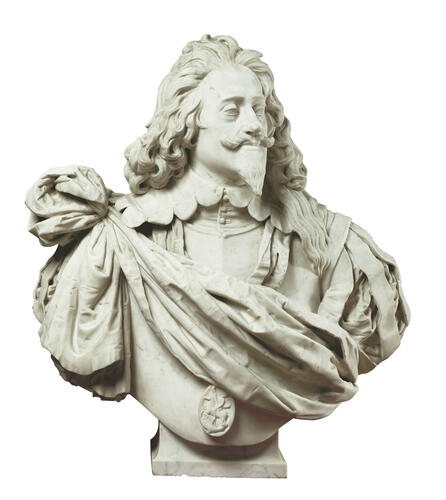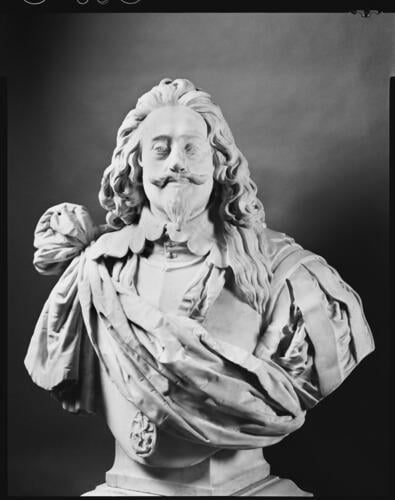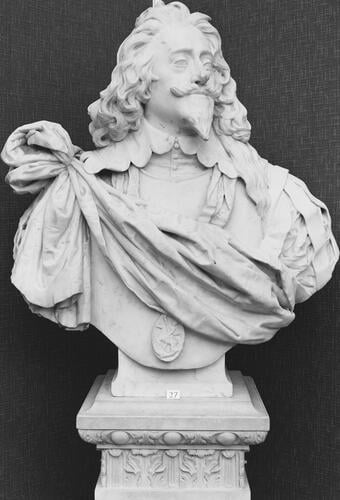-
1 of 253523 objects
Charles I (1600-1649) c. 1700-50
Marble | 86.7 cm (Height) (excluding base/stand) | RCIN 35856
-
A white marble bust of Charles I, wearing a cuirass, a wide, laced collar, a slashed doublet and sash tied at his right shoulder. The badge of the Order of the Garter is suspended on a ribbon round his neck.
Head and shoulders, above life size, The head, with long hair swept up and back, concentrically incised pupils, a broad, horizontal moustache and pointed beard at the chin, is turned slightly to the left and slightly upwards. The hair falls down in front of the left shoulder (with a long flat, tapering ‘tail’ emerging from the more curled locks), and behind at the right. He wears a cuirass over a doublet with slashed sleeves. A broad collar with cusped edges lies over the shoulders revealing at the front the buttons of the doublet. Over the cuirass is a broad ribbon from which is suspended a large Lesser George badge with the saint on a rearing horse spearing a crouching dragon. A scarf is worn diagonally across the breast, with a large knot at the right shoulder. The tip of the nose has been repaired and there are chips and losses in several other places. The bust is deeply hollowed at the back around a central buttress. This is attached by means of a mound of painted plaster to the square marble socle with concave sides. The socle rests on a broader, square marble block with moulded sides and a pedimented front, incised: CARLOUS I / D.G. / ANGLIAE/ SCOTIAE. FRANCIAE / HIBERNIASE. REX. [Charles I by the grace of God king of England, Scotland, France and Ireland]. The bust is supported on a marble pedestal with scroll-ended buttresses at the sides. In front is inserted a rectangular panel carved in relief with the royal arms within a garter, supported by a lion and unicorn and surmounted by a crown.
This imposing bust and another by Blommaendael of William III (RCIN 35857) seem to have been conceived as a pair and made for a large-scale setting, yet their history is unknown before the late-nineteenth century. William III ruled as joint sovereign with Queen Mary II until her death in 1694 and so this pairing of grandfather and grandson was presumably conceived after that date, perhaps as a statement of legitimate title to the English throne. The busts present many challenges to the connoisseur, not least because they have suffered from weathering which has resulted in the complete loss of their original surfaces and a loss of definition to the carving. These effects are also found on the armorial tablets, which may have been salvaged from the original pedestals and re-incorporated in the present ones; these probably date from the late nineteenth century. The Latin inscriptions cut into the new pedestals are in forms commonly found on the coinage of the two sitters, and may have been transcribed from the earlier settings.
The Charles I bust has been regarded since at least 1909 as a replica of the bust ordered by Queen Henrietta Maria from Gianlorenzo Bernini, for which Anthony van Dyck supplied as a pattern the portrait of the king in three positions. Bernini’s work was acclaimed as a masterpiece. Having been delivered to Oatlands for the king and queen’s inspection it was then moved to Greenwich, where it appears in the Inventory prepared by the Commissioners for the sale of the Late King’s Goods. In 1651 it came into the possession of Emanuel de Critz, and at the Restoration it was returned to Charles II who kept it at Whitehall. The bust is assumed to have been destroyed in the fire at Whitehall in 1698. There has been extensive debate over this bust's relationship to the Bernini, but the traditional identification has held.
The evidence suggests that Jan Blommendael or his workshop carved this bust and RCIN 35857 on the basis of an order for an unidentified palace setting in England. This could have come either from the king or from one of the newly powerful grandees of his court such as Arnold Joost van Keppel (1670–1718), 1st Earl of Albermarle. Blommendael invariably signed his works in a prominent style on the side of the support or socle, which in the case of this bust is no longer extant.
Text adapted from Sculpture in the Collection of His Majesty The King (2025)
Provenance
First recorded in the collection of E.J. Coleman of 32 Grosvenor Square, London. Sold Christie's, London, 30 July 1881, lot 104 (wrongly stated in the catalogue to have been at Newstead Abbey); sold by F. Davis in 1881 to Bertram Wodehouse Currie, Minley Manor, Surrey (Inner Hall); his son, Laurence Currie, by whom sold Christie’s, 15 April 1937, lot 63; Purchased by Durlacher for Queen Elizabeth on the encouragement of Kenneth Clark, Surveyor of The King's Pictures (with RCIN 35857), who wrote the day after the sale to congatulate the queen 'on a magnificent purchase, the most important addition to the Royal Collection which has been made for years'.
Placed in the Grand Vestibule at Windsor Castle. The white marble pedestals were ‘altered & adapted’ by Harris of Chiswick in September 1938. Harris was presumably also responsible for the marble additions to the back of the pedestals. The firm also provided new plinths of Clipsham stone, designed by Lord Gerald Wellesley, Surveyor of The King’s
Works of Art. In 1939, the plinths were raised by the insertion of a painted wooden element. -
Creator(s)
(nationality)Acquirer(s)
-
Medium and techniques
Marble
Measurements
86.7 cm (Height) (excluding base/stand)
Category
Object type(s)
Place of Production
Great Britain


